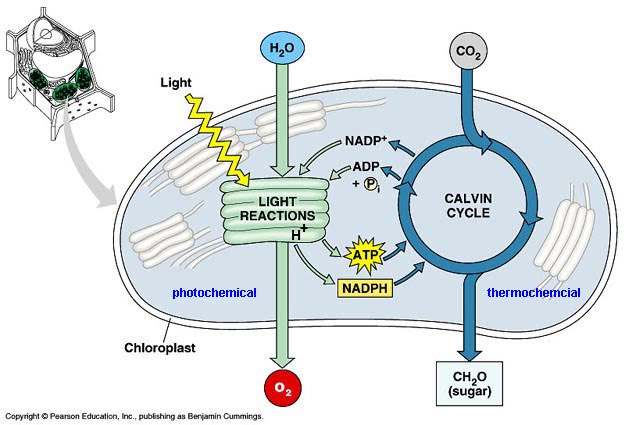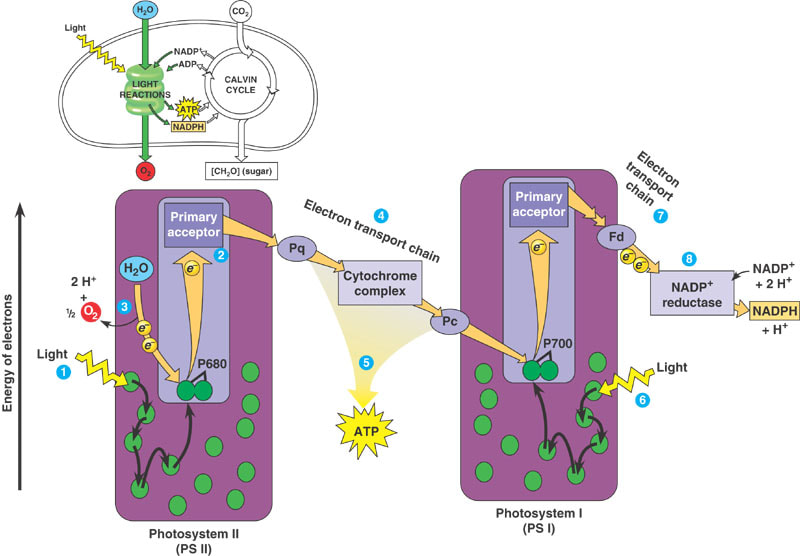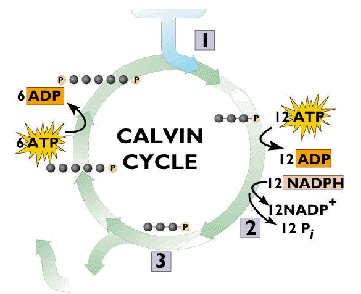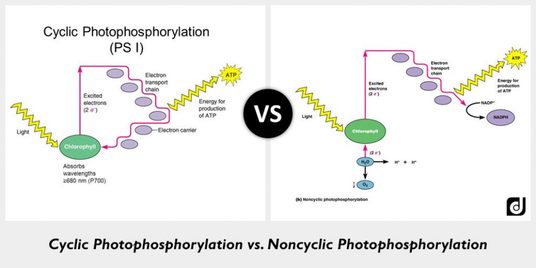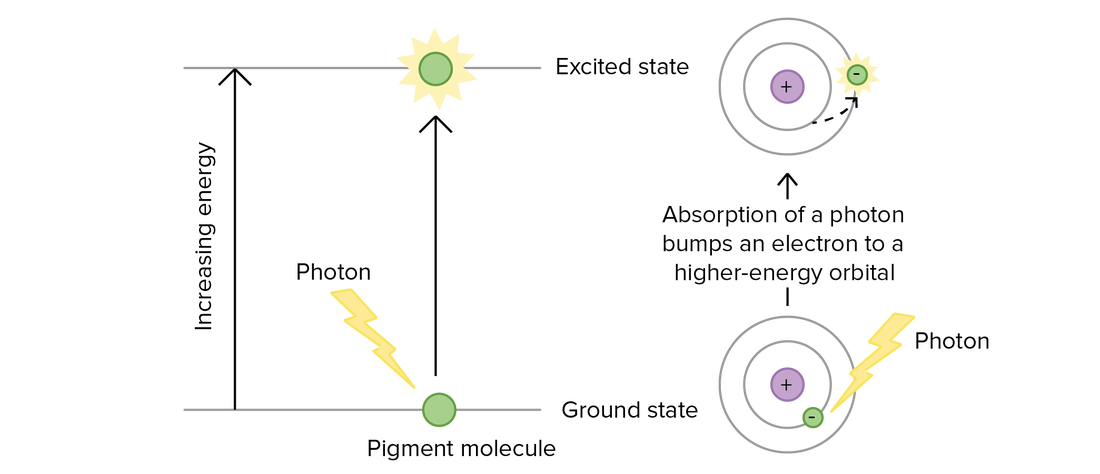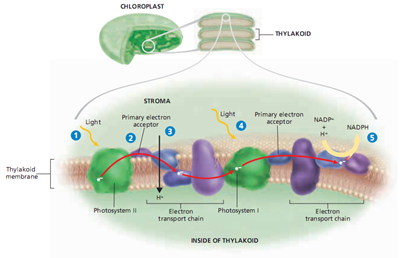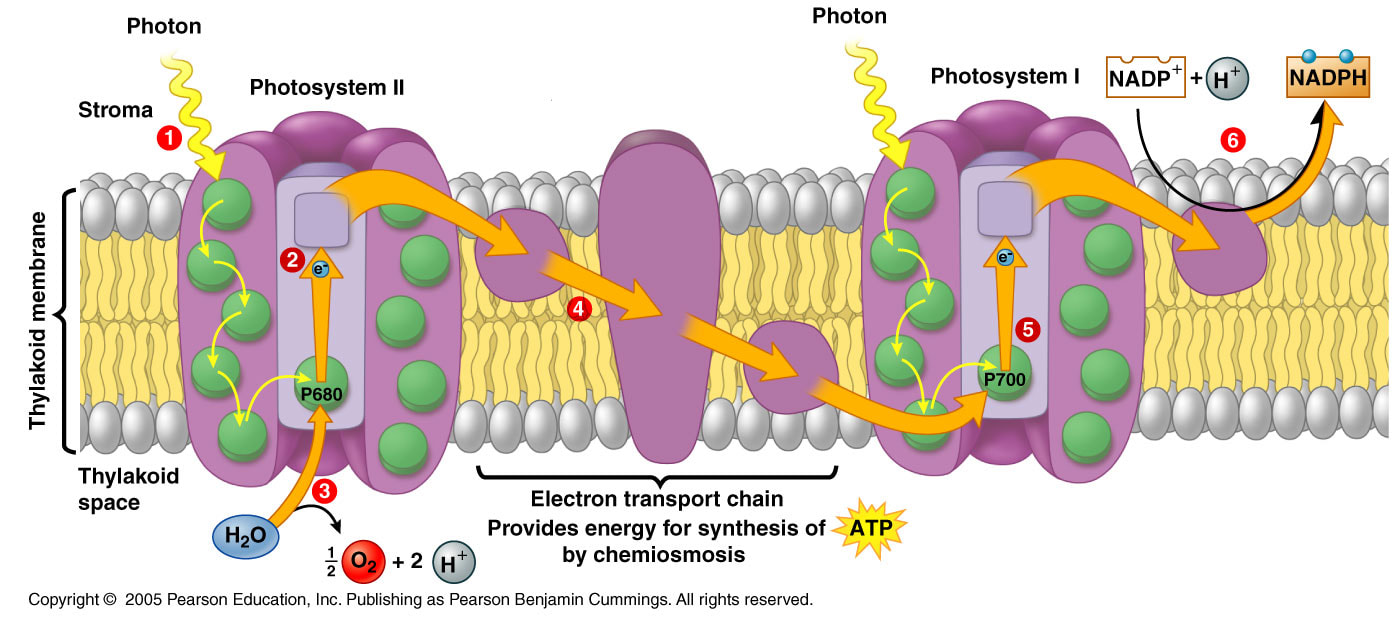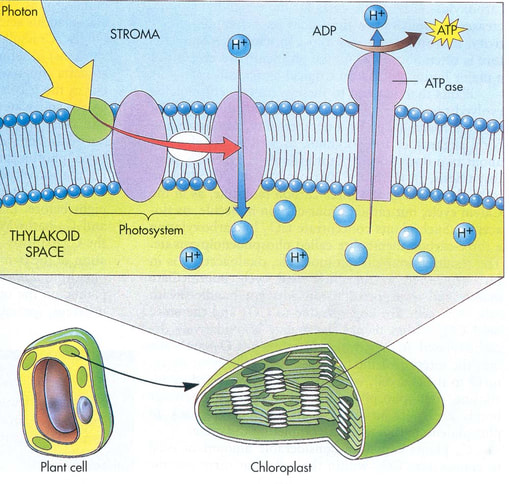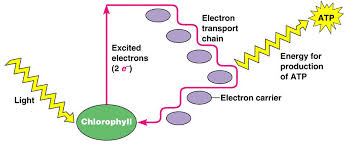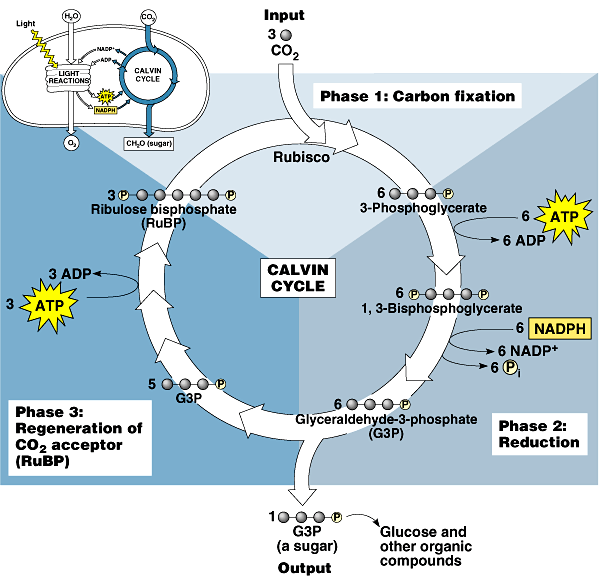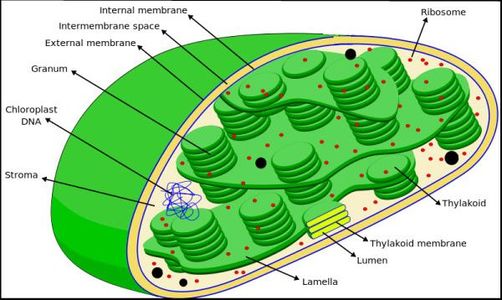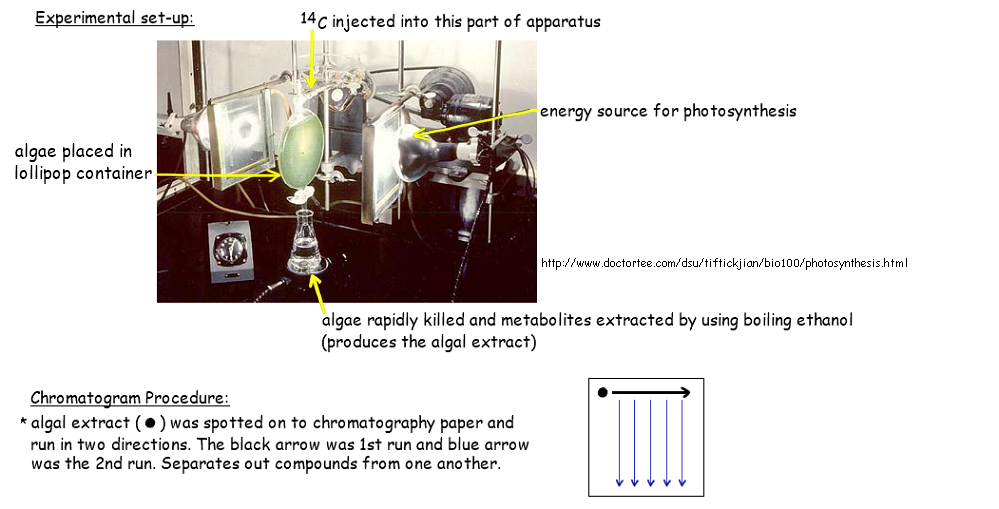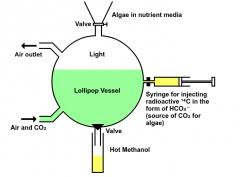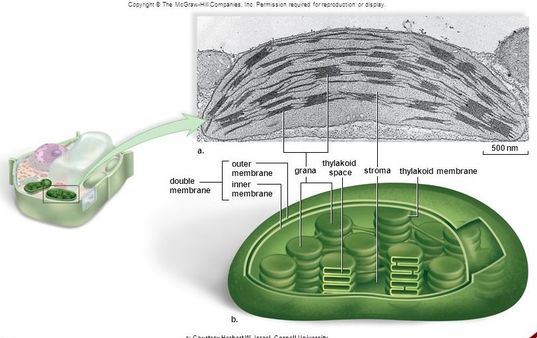Topic 8.3: Photosynthesis

In the Photosynthesis unit we will expand our knowledge from Topic 2.9. We will explore the structure of the chloroplast and identify how it is adapted to absorb light energy. We will also identify specific metabolic pathways of the light dependent and light independent reactions
This unit will last 5 school days
This unit will last 5 school days
Essential idea:
- Light energy is converted into chemical energy.
Nature of science:
- Developments in scientific research follow improvements in apparatus—sources of 14C and autoradiography enabled Calvin to elucidate the pathways of carbon fixation. (1.8)
Understandings
8.3 U 1 Light-dependent reactions take place in the thylakoid membranes and the space inside them.
Photosynthesis is the process by which cells synthesise organic molecules (e.g. glucose) from inorganic molecules (CO2 and H2O) in the presence of sunlight. This process requires a photosynthetic pigment (chlorophyll) and can only occur in certain organisms (plants, some bacteria). In plants, photosynthesis occurs within a specialised organelle called the chloroplast
8.3 U 2 Light-independent reactions take place in the stroma.
The light-independent reactions use the products produced by the light dependent reactions and CO2 to produce glucose.
- The stroma contains enzymes necessary for the light-independent reactions (Calvin Cycle)
- 6 CO2 are required to create one 6 carbon sugar molecule.
- ATP and hydrogen / electrons (carried by NADPH) are transferred to the site of the light independent reactions
- The hydrogen / electrons are combined with carbon dioxide to form complex organic compounds (e.g. carbohydrates)
- The ATP provides the required energy to power these anabolic reactions and fix the carbon molecules together
8.3 U 3 Reduced NADP and ATP are produced in the light-dependent reactions.
The production of ATP by the light dependent reactions is called photophosphorylation, as it uses light as an energy source. Photophosphorylation may be either a cyclic process or a non-cyclic process
This process is the first stage of photosynthesis in which light energy is converted into chemical energy (NADPH and ATP). These products will be used in the light independent stage.
non-cyclic photophosphorylation:
cyclic photophosphorylation:
This process is the first stage of photosynthesis in which light energy is converted into chemical energy (NADPH and ATP). These products will be used in the light independent stage.
non-cyclic photophosphorylation:
- Non-cyclic photophosphorylation involves two photosystems (PS I and PS II) and does involve the reduction of NADP+
- one-way flow of 2 e-s from water to PsII to ETS to PsI to NADP+
- 2 main products: 1(NADPH + H+ 2) ATP
cyclic photophosphorylation:
- involves the use of only one photosystem (PS I) and does not involve the reduction of NADP+cyclic flow of e-s from PsI to ETS back to PsI
- 1 main product: ATP
8.3 U 4 Absorption of light by photosystems generates excited electrons.
The light dependent reactions use photosynthetic pigments (organised into photosystems) to convert light energy into chemical energy (specifically ATP and NADPH)
- Chlorophyll molecules are grouped together into photosystems contained within the thylakoid membranes.
- Chlorophyll a within the photosystem II (PS II) absorbs a photon of light (most efficient at 680 nm).
- This photon of light excites an electron from the chlorophyll a molecule to a higher energy state.
- The chlorophyll is now in a photoactivated state.
- The excited electron is released by the oxidized Chlorophyll a molecule to the primary electron acceptor in photosystem II.
- This electron acceptor is called plastoquinone (PQ)
- PQ accepts two exited electrons and transfers these electrons along a series of electron carriers in the thylakoid membrane
- Photosystem II can repeat this process to produce a second reduced PQ molecule (total of 4e- are used to produce 2 reduced PQ molecules)
8.3.U 5 Photolysis of water generates electrons for use in the light-dependent reactions.
The lost electrons are replaced by the splitting of water through a process called photolysis. During this reaction oxygen is produced and released as a by-product.
- oxidized chlorophyll a (chl+) has a lack of electrons
- replaced as H2O is split: H2O ----> 2 H+ + 2 e-s + 1/2 O2 c. H+:
- remain in thylakoid interior, lowering pH
- contributing to chemiosmotic gradient
- used in phosphorylation of ATP
- 2 electrons: replace electrons lost by chlorophyll a to ETS: chl a+ + 2 e-s ----> chl a
- 1/2 O2: lost to environment as a waste product
8.3 U 6 Transfer of excited electrons occurs between carriers in thylakoid membranes.
The electron moves along a series of electron carriers through a series of redox reactions from photosystem II (PSII) to photosystem I (PSI)
- Electron Carriers: (plastoquinone (PQ) --> cytochrome complex b6f --> lastocyanin --> PS I).
8.3 U 7 Excited electrons from Photosystem II are used to contribute to generate a proton gradient.
As electrons move down the electron transport chain they lose energy. This energy is used to pump H+ (protons) across the thylakoid membrane into the thylakoid space. This creates an H+ concentration gradient and the potential energy needed, that will drive chemiosmosis and produce ATP from ADP during photophosphorylation (similar to oxidative phosphorylation in mitochondria). The photolysis of water also helps create the proton gradient as H+ is produced when water is split
8.3 U 8 ATP synthase in thylakoids generates ATP using the proton gradient.
The production of ATP from ADP and phosphate using energy derived from light is called photophosphorylation.. Photophosphorylation occurs on the thylakoid membrane of the chloroplasts.
- As electrons pass along the electron transport chain between PS II and PS I, the electrons release energy that is used to pump protons from the stroma into the thylakoid space.
- This builds up the concentration of H+ within the thylakoid space creating a proton concentration gradient.
- Protons will flow across the membrane from the thylakoid space to the stroma, through ATP synthase following the concentration gradient.
- As the protons flow through ATP synthase, the energy released from the flow of protons is used to combine ADP and inorganic phosphate to form ATP(photophosphorylation).
- This whole process of producing ATP is called chemiosmosis.
8.3 U 9 Excited electrons from Photosystem I are used to reduce NADP.
- A photon of light strikes photosystem I, re-exciting the electron to a higher energy state (photoactivation)
- This electron is passed along a second electron transport chain (includes ferredoxin) until it is accepted by the final electron carrier NADP+.
- A second electron that follows the same path is also accepted by NADP+.
- These electrons reduce NADP+ to form NADPH (NADP+ + 2e- + H+ --> NADPH).
- This reaction is catalyzed by an enzyme called NADP reductase
- Since the electrons are not returned to photosystem II, this path for making ATP is called non-cyclic photophosphorylation.
- New electrons are passed to PSI from PSII through a carrier called plastocyanin
- If NADP+ runs out and it cannot accept the excited electron from photosystem I, electrons return to the electron transport chain (PQ) where they can reflow back to PS I thus pumping more protons into the thylakoid space; producing more ATP.
- This is called cyclic photophosphorylation.
8.3 U 10 In the light-independent reactions a carboxylase catalyses the carboxylation of ribulose bisphosphate.
The light independent reactions use the chemical energy derived from light dependent reactions to form organic molecules
- One CO2 molecule enters the Calvin cycle and combines with a 5 carbon molecule called Ribulose bisphosphate (RuBP) to temporarily form a 6C molecule.
- This reaction is catalyzed by the enzyme RuBP carboxylase (rubisco).
- This immediately breaks down into two 3C molecules called glycerate-3-phosphate (GP).
8.3 U 11 Triose phosphate is used to regenerate RuBP and produce carbohydrates.
synthesis of carbohydrates and other products:
- enzymes convert TP to various products
- other products: lipids, amino acids, nucleic acids
- polysaccharides: starch
- disaccharides: sucrose
- monosaccharides: glucose, fructose
8.3.U 12 Ribulose bisphosphate is reformed using ATP.
Two TP molecules are used to produce one six carbon glucose phosphate molecule, which can eventually be combined with other glucose phosphate to form starch.
- The other ten TP (3C) molecules are used to regenerate six RuBP (5C) using 6 ATP molecules for energy.
- So for every 6 triose phosphate molecules produced, 5 of these triose (3C) sugars are used to reform 3 RuBP (5C) molecules using 3 ATP molecules The one remaining triose phosphate forms half a glucose phosphate
8.3 U 12 The structure of the chloroplast is adapted to its function in photosynthesis.
- chloroplast has double membrane regulating internal conditions
- chloroplast interior separated into thylakoids and stroma
- thylakoids = site of light dependent reactions
- large surface area to maximize light absorption
- small space inside thylakoids allows for proton accumulation
- thylakoid interior acidic/ pH = 4/ high proton concentration allowing for chemiosmotic gradient
- stroma = site of light independent reactions
- stroma pH = 8/ basic where Calvin cycle enzymes function optimally
- thylakoids = site of light dependent reactions
- thylakoid membranes hold photosystem pigments
- pigments anchor in thylakoid membranes by hydrophobic/ hydrocarbon tails
- photolysis enzymes on inner surface of thylakoid membrane for splitting water into oxygen and hydrogen
- intrinsic proteins bound in thylakoid membranes allow electron transport/ ETC between PsII and PsI
- ETC proteins between photosystems II and I pump protons into thylakoid interior adding to chemiosmotic gradient
- NADP reductase bound to outer thylakoid membrane allowing reduction of NADP to NADPH for Calvin cycle
- ATP synthase transmembrane complex bound across thylakoid membrane
- allowing proton flow down chemiosmotic gradient/ photophosphorylation/ ATP production in stroma
- chloroplast DNA allows for protein synthesis
- chloroplast ribosomes allow for protein synthesis
- chloroplast starch granules allow for storage of photosynthetic products
Application
8.3 A 1 Calvin’s experiment to elucidate the carboxylation of RuBP.
The light independent reactions are also collectively known as the Calvin cycle – named after American chemist Melvin Calvin. Calvin mapped the complete conversion of carbon within a plant during the process of photosynthesis. The experiments performed by Melvin Calvin explained the process that plants use to make food. Radioactively labeled carbon was introduced into algae and analyzed to see where it would be found in the cells by the use of two-dimensional paper chromatography. The results of these experiments showed that carbon dioxide was converted to carbohydrates during the light-independent reactions of photosynthesis.
Skill
8.3 S 1 Annotation of a diagram to indicate the adaptations of a chloroplast to its function.
Electron micrographs of a chloroplast may differ in appearance depending on where the cross-section occurs
Typically, chloroplast diagrams should display the following features:
Typically, chloroplast diagrams should display the following features:
- Usually round in appearance with a double membrane exterior
- Flattened discs (thylakoids) arranged into stacks (grana), connected by lamellae
- Internal lumen of thylakoids is very small (allows for a more rapid generation of a proton motive force)
- Ribosomes and chloroplast DNA are usually not visible at standard resolutions and magnifications
- Starch granules may be visible and will appear as dark spots within the chloroplast
Key Terms
|
photosynthesis
Light-dependent reactions light dependent reactions ATP triosphosphate Photosystem I photolysis electron transport chain triose phosphate autoradiography |
chloroplast
photoactivation synthesis light energy photosystem Calvin Cycle ATP synthesis carbon fixation prokaryotes thylakoid lumen |
photolysis
grana NADP photon reaction center photoactivation pigments carboxylation carbon-14 |
stroma
electron transport NADPH carbon fixation RuBP plastoquinone (Pq) proton gradient G3P light waves |
thylakoid
chemiosmosis ADP carboxylation Photosystem II electrons carboxylase rubisco chromatography |
PowerPoint and Notes on Topic 8.3 by Chris Payne
Your browser does not support viewing this document. Click here to download the document.
Your browser does not support viewing this document. Click here to download the document.
Correct use of terminology is a key skill in Biology. It is essential to use key terms correctly when communicating your understanding, particularly in assessments. Use the quizlet flashcards or other tools such as learn, scatter, space race, speller and test to help you master the vocabulary.
Useful Links
Photosynthesis Overview Animation
In The News
Molecular system for artificial photosynthesis, Science Daily, June 2, 2017
Australian scientists are a step closer to converting sunlight and water into fuel, Science Alert, August 27, 2014
TOK
- The lollipop experiment used to work out the biochemical details of the Calvin cycle shows considerable creativity. To what extent is the creation of an elegant protocol similar to the creation of a work of art?
Video Clips
Learn how the light dependent and light independent cycles work together to create glucose for plants.
We get energy by eating other organisms, but plants don't have to do that. They can build their own food out of water, carbon dioxide, and sunlight. I'm sure you've heard of photosynthesis before, but let's take a look at some of the finer points, shall we?
A hearty bowl of cereal gives you the energy to start your day, but how exactly did that energy make its way into your bowl? It all begins with photosynthesis, the process that converts the air we breathe into energizing glucose. Cathy Symington details the highly efficient second phase of photosynthesis -- called the Calvin cycle -- which converts carbon dioxide into sugar with some clever mix-and-match math.
The Calvin Experiment

